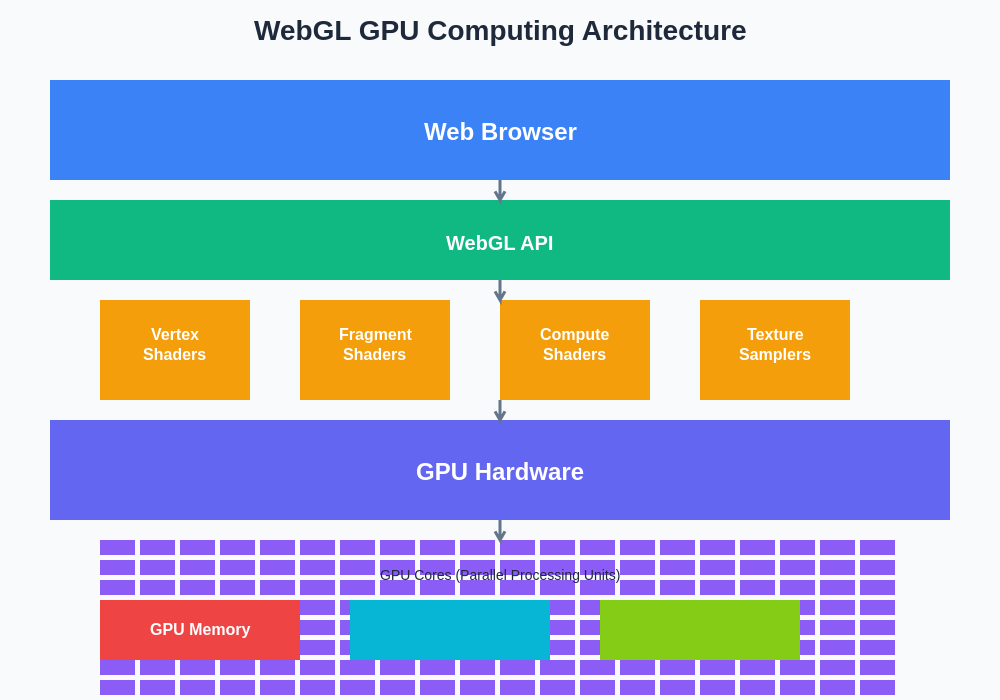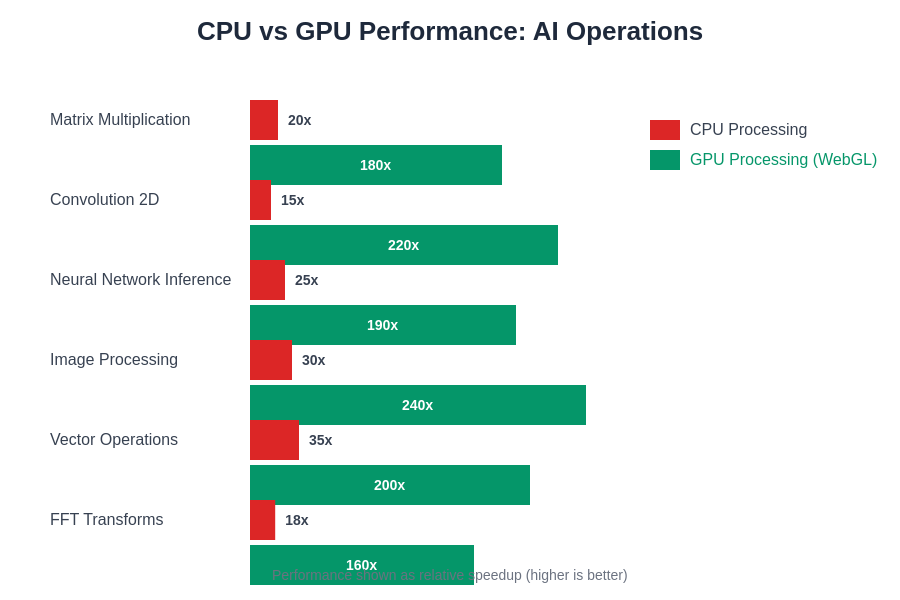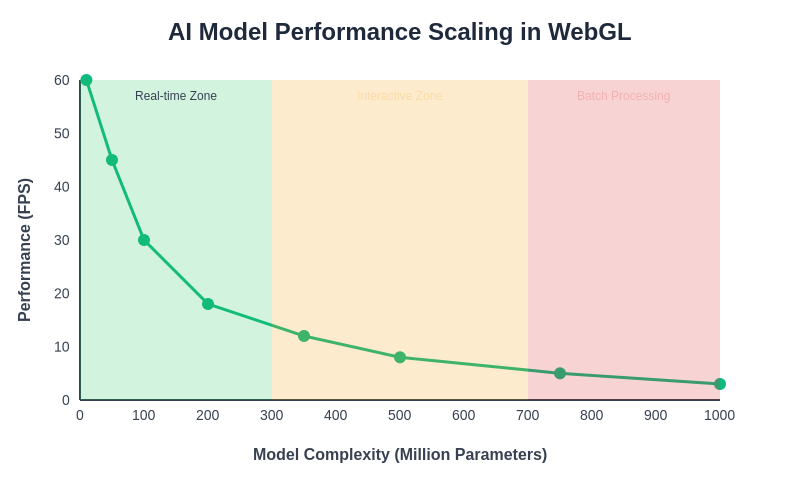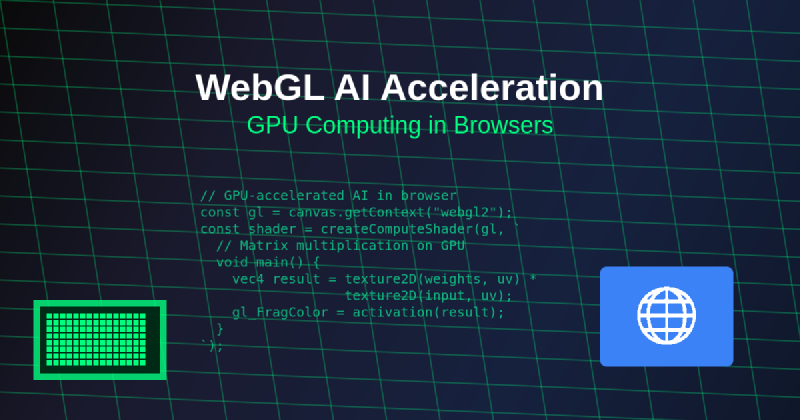The convergence of artificial intelligence and web technologies has reached a revolutionary milestone with the emergence of WebGL-powered GPU acceleration for machine learning computations. This groundbreaking approach transforms web browsers from simple document viewers into powerful computational platforms capable of running sophisticated AI models locally, eliminating the need for server-side processing and opening unprecedented possibilities for privacy-preserving, low-latency AI applications.
Discover the latest AI development trends that are shaping the future of browser-based artificial intelligence and GPU computing technologies. The integration of GPU acceleration into web browsers represents a fundamental shift in how we conceptualize and deploy AI applications, bringing enterprise-level computational capabilities directly to end users while maintaining the accessibility and ubiquity that make web applications so powerful.
The Foundation of Browser-Based GPU Computing
WebGL, originally designed for rendering high-performance 3D graphics in web browsers, has evolved into a versatile platform for general-purpose GPU computing tasks. This transformation leverages the parallel processing capabilities of modern graphics cards to perform complex mathematical operations that are essential for machine learning algorithms. Unlike traditional CPU-based computations that process data sequentially, GPU-accelerated operations can handle thousands of concurrent calculations, making them ideally suited for the matrix operations and tensor manipulations that form the backbone of neural networks.
The architectural advantages of GPU computing become particularly pronounced when dealing with large-scale AI models. Modern graphics processors contain thousands of cores optimized for parallel execution, enabling them to process multiple data points simultaneously rather than sequentially. This parallel processing capability translates directly into significant performance improvements for machine learning tasks, with speed increases often measuring in orders of magnitude compared to CPU-only implementations.
Transforming Client-Side AI Performance
The implementation of WebGL-based AI acceleration has fundamentally altered the performance characteristics of browser-based machine learning applications. Traditional web-based AI relied heavily on server-side processing, introducing latency, bandwidth limitations, and privacy concerns that constrained the development of responsive AI applications. WebGL acceleration eliminates these bottlenecks by enabling complex neural network computations to execute directly on the user’s hardware, achieving processing speeds that rival dedicated machine learning frameworks.
This transformation is particularly evident in real-time applications such as computer vision, natural language processing, and interactive AI experiences. Tasks that previously required multiple round-trips to remote servers can now be completed in milliseconds on local hardware, enabling new categories of applications that were previously impractical due to latency constraints. The ability to process sensitive data locally also addresses privacy concerns that have limited the adoption of cloud-based AI services in certain domains.

The architectural design of WebGL-based AI acceleration creates a sophisticated pipeline that efficiently utilizes GPU resources while maintaining compatibility with standard web technologies. This integration enables developers to harness the full computational power of modern graphics hardware without requiring specialized plugins or native applications.
Experience advanced AI capabilities with Claude for development tasks that require sophisticated reasoning and code generation capabilities. The combination of powerful AI assistants with GPU-accelerated browser computing creates unprecedented opportunities for developing intelligent web applications that can operate entirely within the client environment.
Enabling Advanced Neural Network Operations
The mathematical operations required for neural network computations align naturally with the capabilities of GPU hardware, making WebGL an ideal platform for implementing complex AI algorithms in web browsers. Matrix multiplications, convolutions, and activation functions can all be efficiently implemented using WebGL shaders, which are programs that run directly on the GPU and can process multiple data elements in parallel. This alignment between AI computational requirements and GPU architecture has enabled the development of sophisticated neural network libraries that operate entirely within the browser environment.
The implementation of neural network operations through WebGL requires careful consideration of memory management, data layout, and shader optimization to achieve optimal performance. Modern WebGL implementations provide access to advanced GPU features such as compute shaders, uniform buffer objects, and texture arrays that enable efficient implementation of complex neural network architectures. These capabilities allow developers to implement everything from simple feedforward networks to sophisticated transformer models directly in the browser.
Revolutionizing Real-Time Computer Vision
Computer vision applications represent one of the most compelling use cases for WebGL-powered AI acceleration, as they typically require processing large amounts of visual data in real-time. Traditional browser-based computer vision applications were severely limited by the computational constraints of JavaScript execution, often requiring significant compromises in model complexity or processing speed. WebGL acceleration has eliminated these limitations, enabling sophisticated computer vision models to operate at interactive frame rates directly in web browsers.
The impact of this capability extends across numerous applications, from augmented reality experiences that require real-time object detection and tracking to medical imaging applications that need to process complex visual data with high precision. The ability to perform these computations locally also addresses privacy concerns associated with uploading sensitive visual data to remote servers, making browser-based computer vision applications viable for applications involving personal or confidential information.
Advancing Natural Language Processing Capabilities
Natural language processing represents another domain where WebGL acceleration has delivered transformative improvements in browser-based AI capabilities. Large language models, which require extensive computational resources for both training and inference, can now be deployed directly in web browsers through efficient GPU acceleration techniques. This development has enabled the creation of sophisticated text processing applications that can operate without internet connectivity while maintaining the responsiveness required for interactive user experiences.
The implementation of NLP models through WebGL requires specialized techniques for handling the sequential nature of language data while maximizing the parallel processing capabilities of GPU hardware. Techniques such as batched processing, attention mechanism optimization, and efficient tokenization have been developed specifically for browser-based deployment, enabling complex language models to achieve performance levels that were previously only possible with dedicated server infrastructure.

The performance advantages of GPU acceleration become dramatically apparent when comparing processing times for common AI tasks. The parallel architecture of modern graphics processors delivers substantial improvements across virtually all machine learning operations, with the most significant gains observed in tasks involving large matrix operations and parallel data processing.
Frameworks and Tools for WebGL AI Development
The development ecosystem for WebGL-powered AI has matured significantly, with several comprehensive frameworks providing high-level abstractions that simplify the implementation of GPU-accelerated machine learning applications. TensorFlow.js stands as the most prominent example, offering WebGL backend support that automatically accelerates tensor operations using GPU resources. This framework enables developers to deploy pre-trained models or implement custom neural networks with minimal modifications to their existing JavaScript code.
Other specialized frameworks have emerged to address specific aspects of WebGL AI development, including libraries focused on computer vision, natural language processing, and reinforcement learning applications. These tools provide optimized implementations of common AI operations while abstracting away the complexities of WebGL shader programming and GPU memory management. The availability of these frameworks has significantly reduced the technical barriers to implementing GPU-accelerated AI in web applications.
Enhance your research capabilities with Perplexity for comprehensive information gathering and analysis tasks related to emerging AI technologies and development frameworks. The rapid evolution of WebGL AI tools requires continuous learning and adaptation to leverage the latest capabilities effectively.
Memory Management and Optimization Strategies
Effective memory management represents one of the most critical aspects of WebGL AI implementation, as GPU memory constraints can significantly impact both performance and the complexity of models that can be deployed. Unlike CPU-based applications that can rely on virtual memory systems, GPU computing requires careful planning of memory allocation and data movement to achieve optimal performance. WebGL applications must efficiently manage texture memory, buffer objects, and shader variables to maximize the utilization of available GPU resources.
Optimization strategies for WebGL AI applications involve multiple layers of consideration, from high-level algorithmic choices to low-level shader implementation details. Techniques such as memory pooling, batch processing, and strategic data layout can dramatically improve performance while reducing memory fragmentation. Advanced optimization approaches include the implementation of custom memory allocators, the use of compressed data formats, and the development of streaming algorithms that can process datasets larger than available GPU memory.
Cross-Platform Compatibility and Deployment
One of the most significant advantages of WebGL-based AI acceleration is its inherent cross-platform compatibility, enabling AI applications to run consistently across different operating systems, devices, and hardware configurations. This universality stems from the standardized nature of WebGL, which provides a consistent interface to GPU resources regardless of the underlying graphics hardware or operating system. Applications developed using WebGL AI acceleration can seamlessly transition between desktop computers, mobile devices, and even embedded systems without requiring platform-specific modifications.
The deployment advantages of WebGL AI extend beyond simple compatibility to encompass ease of distribution and maintenance. Applications can be deployed through standard web hosting infrastructure and automatically updated through browser caching mechanisms, eliminating the complexity associated with native application distribution. This deployment model also enables progressive loading strategies where AI models can be downloaded and cached as needed, optimizing initial loading times while providing full functionality when required.
Security and Privacy Considerations
The local execution of AI computations through WebGL acceleration addresses several important privacy and security concerns that have limited the adoption of cloud-based AI services. By processing sensitive data entirely within the user’s browser, WebGL AI applications can provide strong privacy guarantees without requiring users to trust third-party services with their personal information. This capability is particularly valuable for applications involving medical data, financial information, or other sensitive content where privacy requirements may prohibit cloud-based processing.
However, the implementation of WebGL AI applications also introduces unique security considerations that developers must address. GPU access through WebGL can potentially be exploited for side-channel attacks or unauthorized resource utilization, requiring careful implementation of security measures and resource limits. Browser vendors have implemented various protections against these threats, but application developers must remain vigilant about security best practices and stay current with emerging threat vectors.
Performance Benchmarking and Optimization
The performance characteristics of WebGL AI applications depend on numerous factors, including the specific AI model architecture, the target hardware configuration, and the efficiency of the WebGL implementation. Comprehensive benchmarking is essential for understanding these performance trade-offs and optimizing applications for specific use cases and deployment scenarios. Modern benchmarking approaches evaluate not only raw computational performance but also factors such as memory utilization, power consumption, and thermal characteristics that can impact user experience.
Optimization techniques for WebGL AI applications span multiple levels of the software stack, from algorithmic improvements that reduce computational requirements to low-level shader optimizations that maximize GPU utilization. Profile-guided optimization, where applications are tested across representative hardware configurations and workloads, has proven particularly effective for identifying performance bottlenecks and optimization opportunities. Advanced optimization techniques include the implementation of dynamic batching strategies, adaptive precision schemes, and workload-aware resource allocation algorithms.

The relationship between model complexity and performance in WebGL AI applications demonstrates clear scaling patterns that inform optimal deployment strategies. Understanding these performance characteristics enables developers to make informed decisions about model architecture and deployment configurations that balance computational requirements with user experience objectives.
Integration with Emerging Web Technologies
The continued evolution of web standards is expanding the capabilities available for WebGL AI applications, with emerging technologies promising even greater performance and functionality. WebGPU, the next-generation graphics API for the web, offers more direct access to modern GPU capabilities and promises to further improve the performance of browser-based AI applications. The integration of WebAssembly with GPU computing provides additional opportunities for optimizing critical computational kernels while maintaining the portability and security benefits of web-based deployment.
Progressive Web App technologies enable WebGL AI applications to provide native-app-like experiences while maintaining the advantages of web-based distribution and updates. Service workers can implement sophisticated caching strategies for AI models and computational resources, while web app manifests enable installation and offline operation. These technologies combine to create a compelling platform for deploying sophisticated AI applications that rival native implementations in functionality while exceeding them in accessibility and ease of deployment.
Future Directions and Technological Evolution
The trajectory of WebGL AI development points toward increasingly sophisticated capabilities that will further blur the line between web applications and native software. Advances in GPU hardware, including specialized AI acceleration units and increased memory capacities, will enable more complex models to run efficiently in browser environments. The development of more efficient neural network architectures optimized specifically for GPU execution will further improve the performance and capabilities of browser-based AI applications.
The integration of federated learning capabilities with WebGL AI platforms represents another promising direction for technological development. This approach could enable collaborative model training across distributed browser environments while maintaining privacy and reducing the computational burden on individual devices. Such systems could facilitate the development of personalized AI models that improve through collective learning while preserving user privacy and data sovereignty.
The continued advancement of WebGL AI acceleration promises to democratize access to sophisticated artificial intelligence capabilities by making them available through the ubiquitous web platform. This democratization has the potential to accelerate AI innovation by reducing deployment barriers and enabling rapid experimentation with new AI applications and use cases. The convergence of powerful AI capabilities with the accessibility and reach of web technologies represents a fundamental shift in how artificial intelligence will be developed, deployed, and experienced by users worldwide.
Disclaimer
This article is for informational purposes only and does not constitute professional advice. The views expressed are based on current understanding of WebGL AI acceleration technologies and their applications. Readers should conduct their own research and consider their specific requirements when implementing GPU-accelerated AI applications in web browsers. Performance characteristics and capabilities may vary significantly depending on hardware configurations, browser implementations, and specific use cases. The effectiveness of WebGL AI acceleration depends on numerous factors including device capabilities, model complexity, and implementation quality.
